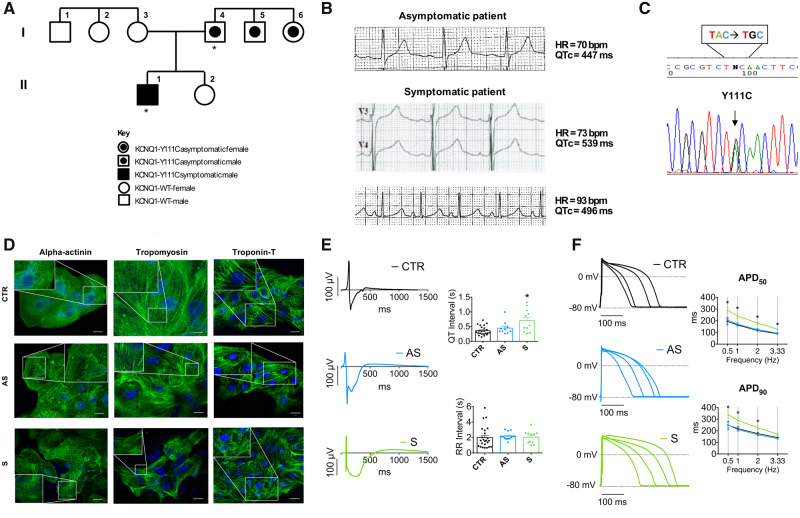Figure 1.
Generation of patient-specific iPSC-CMs. (A) Pedigree of the family segregating the KCNQ1-Y111C mutation. The asterisks indicate the two subjects enrolled in the study: the symptomatic (S) proband is a 16-year-old boy (II-1) with an episode of syncope with sphincter release during a combined emotional and physical stress, while the father (I-4) has never experienced symptoms, i.e. he is an asymptomatic carrier (AS). Other two family members, one uncle (I-5) and one aunt (I-6) of the S proband also carry the same heterozygous mutation, but their QT interval is normal and they have never experienced symptoms. (B) Electrocardiogram tracings. Representative electrocardiograms of the AS individual and of the S patient at age 8 prior to institution of β-blocker therapy. Rate corrected QT interval (QTc, Bazett’s formula) are indicated at the top of the tracings. (C) DNA sequencing. The analysis shows the presence of the heterozygous 332 A>G mutation in the KCNQ1 coding region, resulting, at protein level, in the substitution of the tyrosine (Y) in position 111 with a cysteine (C). (D) iPSC-CMs. Cardiac differentiation was demonstrated by expression of alpha-actinin, cardiac troponin-T, and tropomyosin (green) organized to form cross-striations (insets). Nuclei were stained with Hoechst 33258 (blue). Scale bar = 20 μm. (E) Multi-Electrode array analysis. Representative field potential recordings (left) of CTR-, AS-, and S-iPSC-CMs. Average values for QT- and RR interval durations recorded in spontaneously beating EBs from CTR-, AS-, and S-iPSC-CMs (right) (*P < 0.05; n = 10–23). (F) Action potentials. APs recorded with IK1 injection by dynamic clamp in CTR-, AS-, and S-iPSC-CMs paced at 0.5, 1, 2, and 3.33 Hz (*P < 0.05 vs. S; n = 7–13). One-way ANOVA for unpaired measurements was applied to MEA and patch-clamp data. Post hoc comparison among individual means was performed with Tukey’s method.

